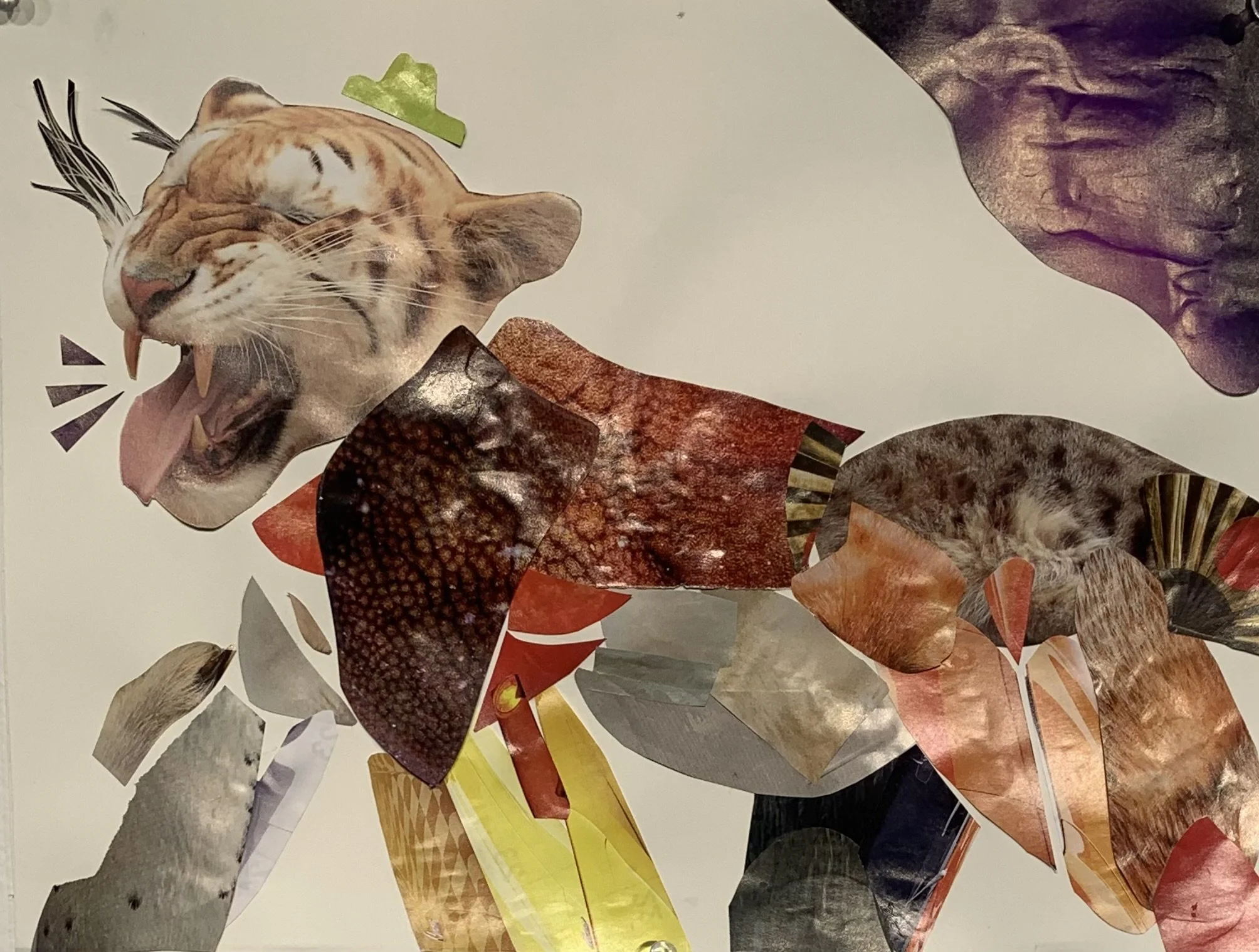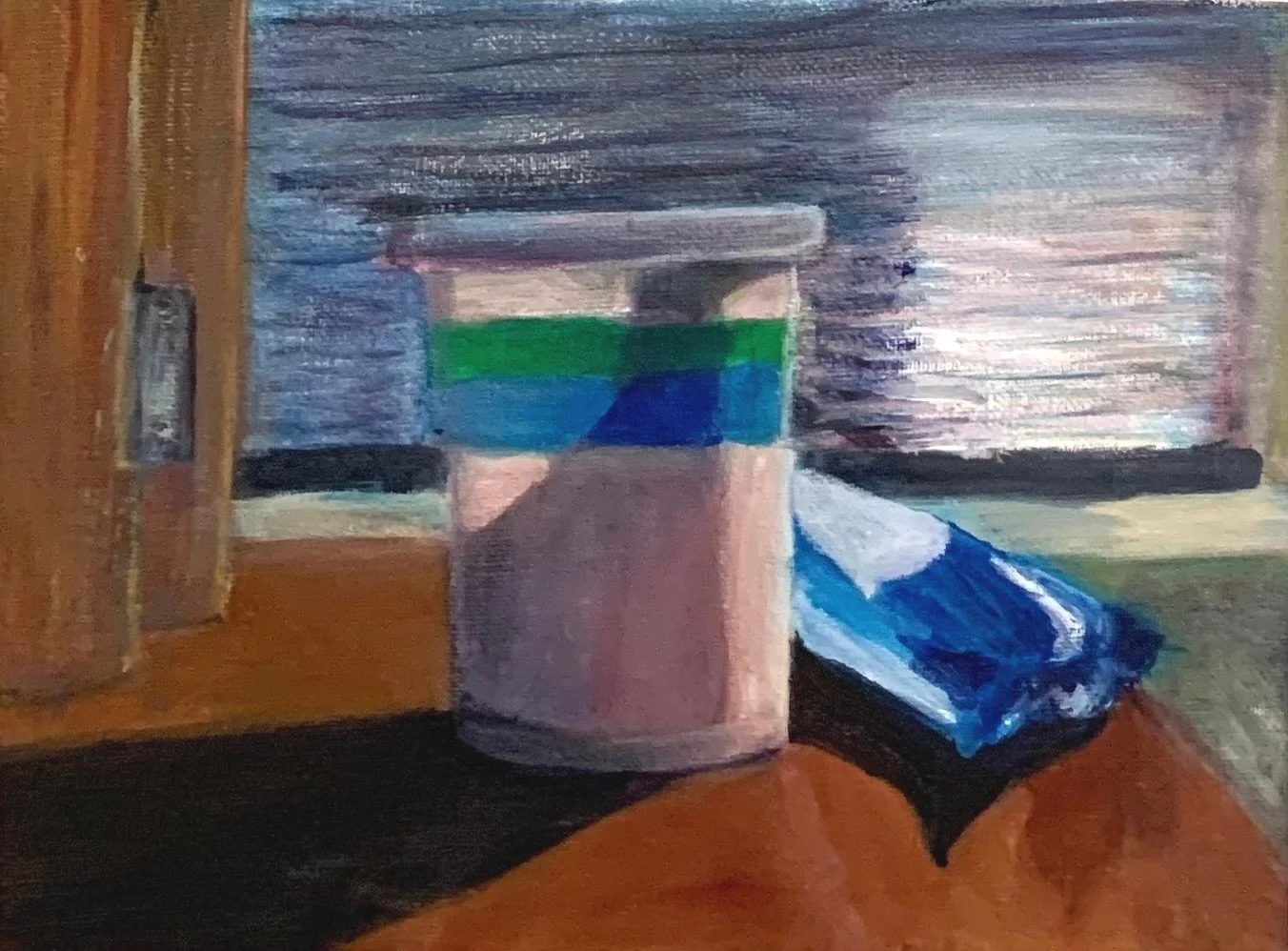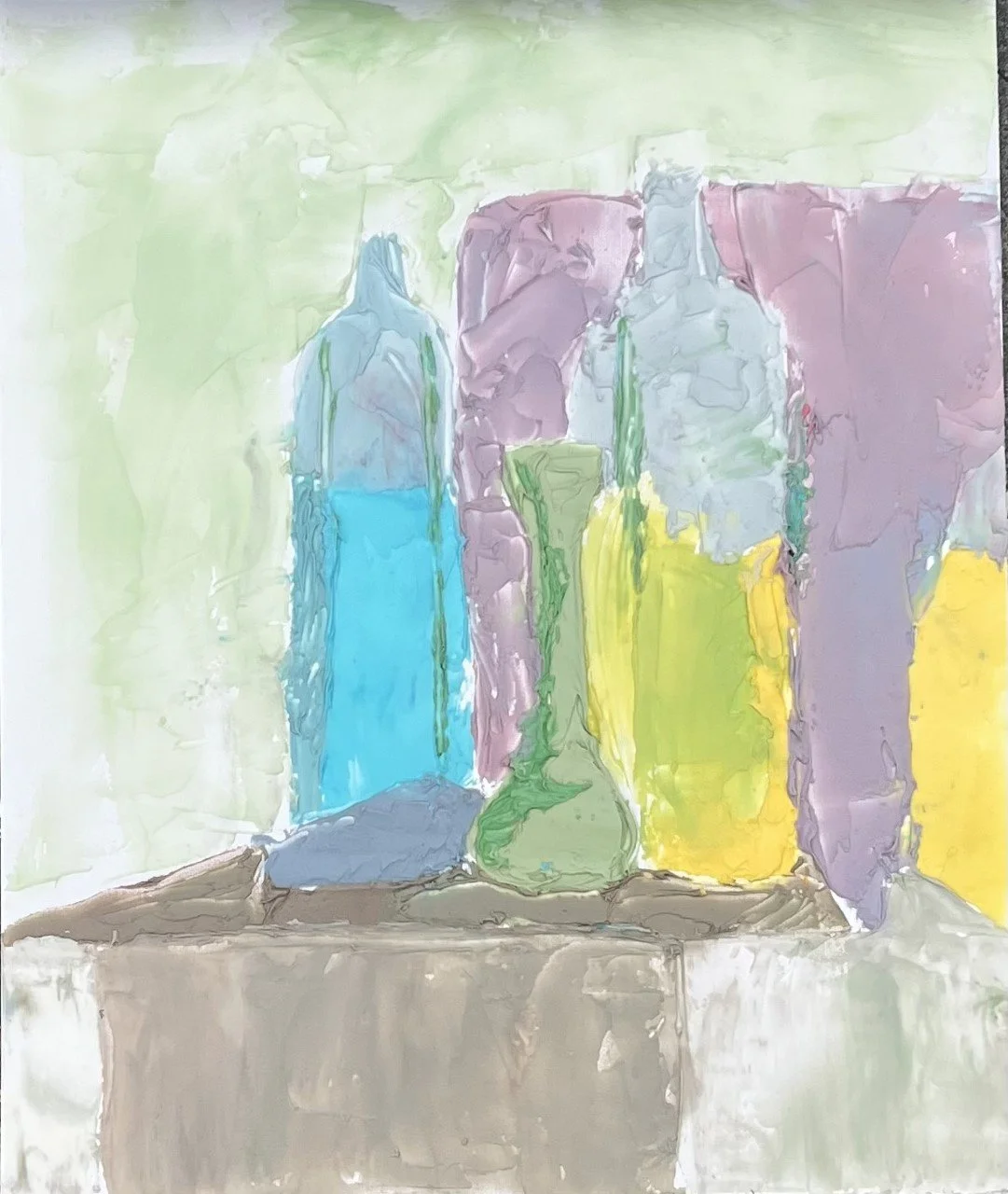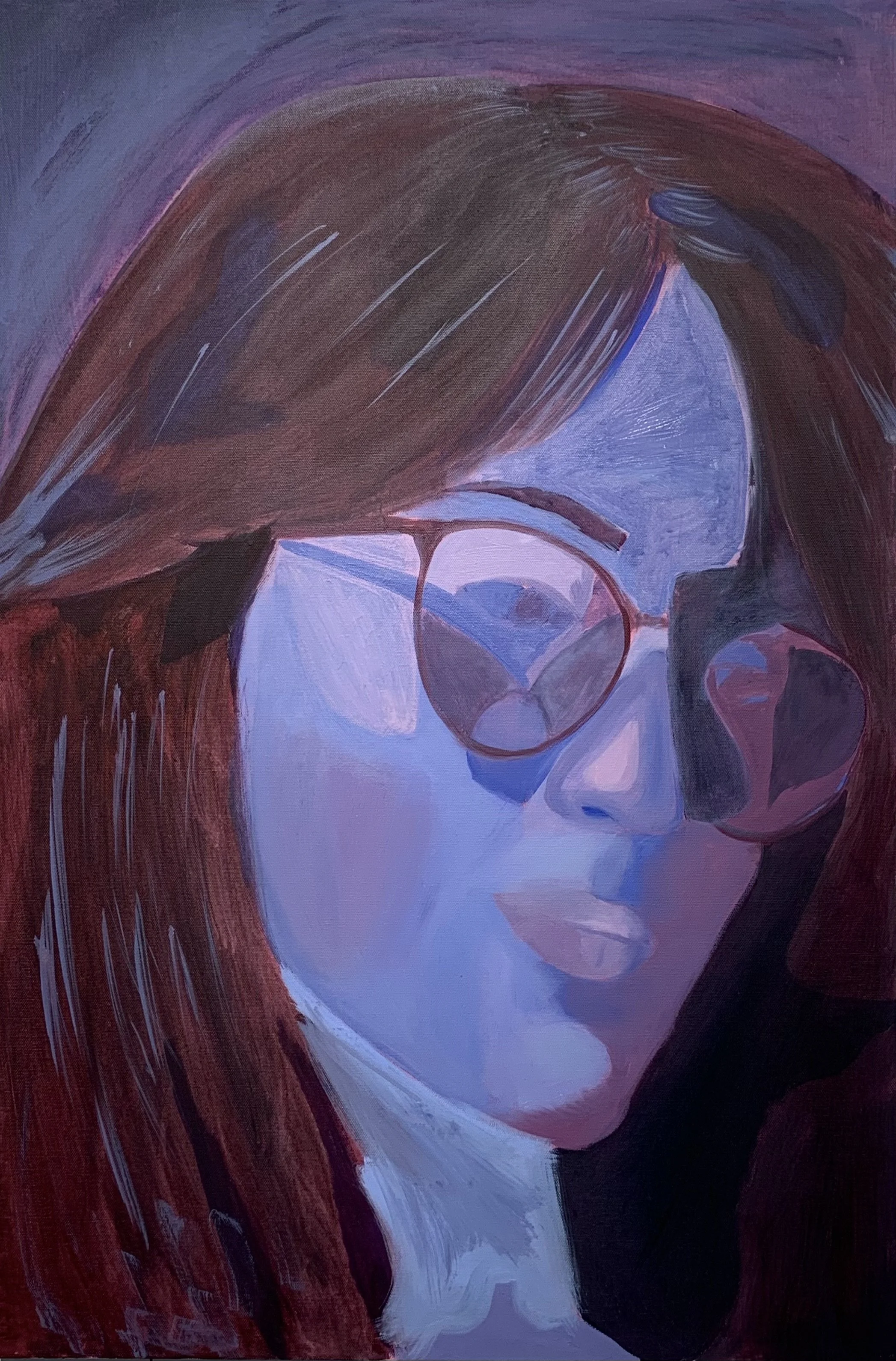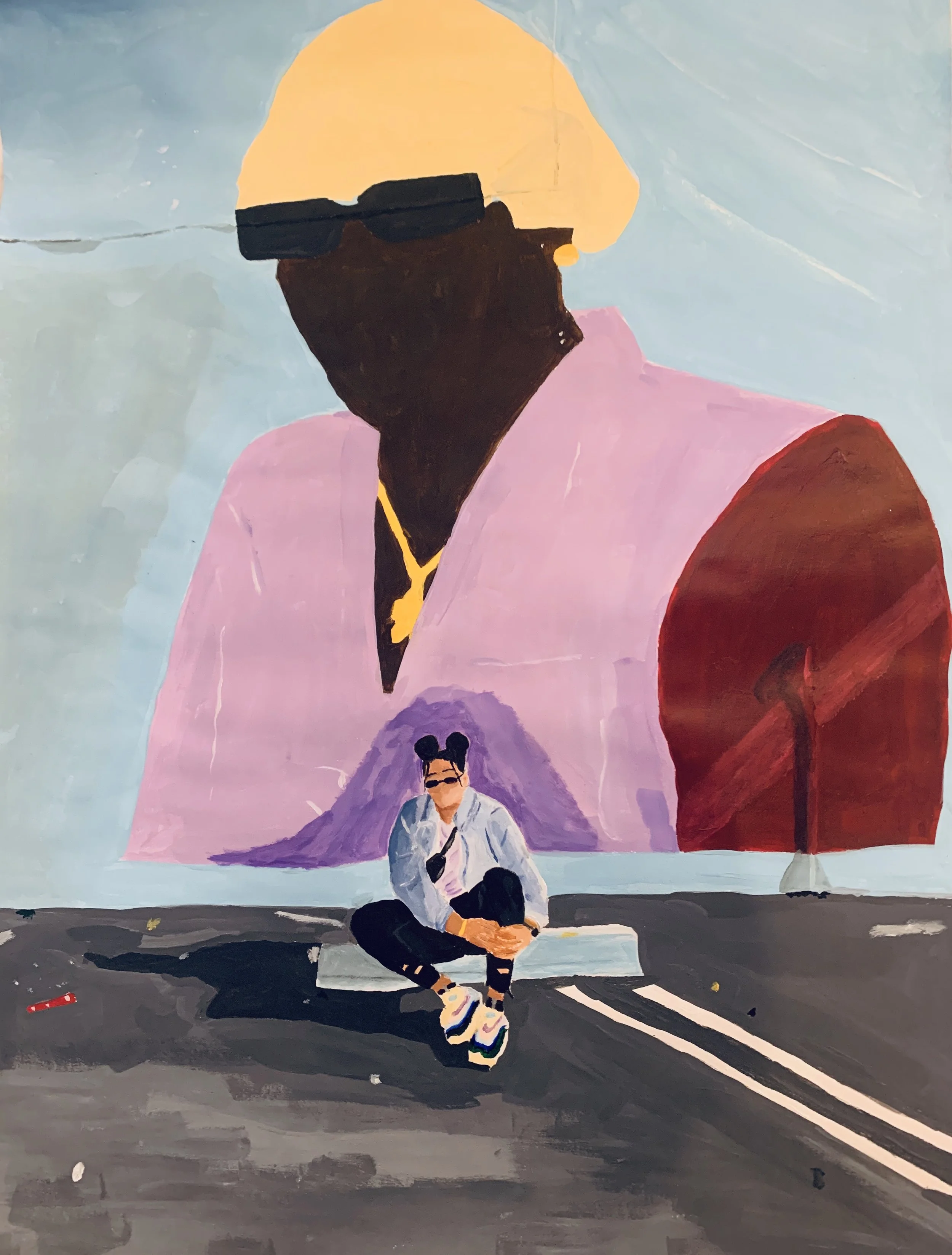Student Work
Introductory, Intermediate and Advanced Painting Courses
Color Matching Project
This assignment consists of two separate parts - a collage and a painting. The students are encouraged to explore their collage in the context of the various topics discussed in class, and play around with it as they see fit. We discuss works by Mickalene Thomas, Tschabalala Self and Adrian Ghenie. The collage is then used as a reference for the painting, which is a technical exercise in seeing and mixing color, using only a split primary palette of six colors and white.
Painting I, Hofstra University
Colored Light
For this assignment, the students paint from a still life that is set up for them in class, and is lit up by a colored light (usually green, red or blue). The students have previously painted the same set up under regular lighting for another exercise, so they are thoroughly familiar with it, and thus are more aware of the change. The colored lighting significantly alters the observed local colors in both light and shadows, and forces the students to watch carefully and make no assumptions.
This assignment trains observational skills, develops trust in perception, and demonstrates the importance of the color of light, and the complementary nature of the light/shadow color relationship.
Painting II, Hofstra University
Dead Palette Painting
In this assignment the students paint a still life by using traditional dead palette primary colors: Paynes Gray, Yellow Ochre, and Burnt Sienna. The narrow color range provides an opportunity to learn color mixing without the overwhelm of high saturation, and observe how juxtaposing complementary colors reinforces them, while mixing together neutralizes them. The students usually make this painting as an introduction to color after starting the semester in monochrome. Upon demonstrating their ability to control the dead palette colors, the students then proceed to painting with three saturated primaries, such as Phthalo Blue, Alizarin Crimson, Cadmium Yellow, and white.
Painting I, Hofstra University
Painting III, Dingle, Ireland Summer Painting Study Abroad Program
Flat Pattern of Color
This assignment is an exercise in perceiving and mixing color, abstracting the visual field, and eliminating detail in favor of large forms. The students make four small paintings consisting of no more than 4-5 shapes of color. They are encouraged to be selective in their choice of compositions, and then mix their color precisely to match their observation. In order to prepare them for this project, we discuss both abstract and representational painting such as color field works, the Bay Area Movement, and relevant contemporary artists.
Alla Prima Painting, UCSD, Continuing Education
The Omnipresence of Color
For this assignment, the students arrange a number of highly chromatic, reflective objects of their choice under a bright light (preferably sunlight). The objects create refractions, cast shadows and reflect colors within each other and the surface they’re placed on. The shadows are alive with the rich colors bouncing around the space. The students are encouraged to emphasize those relationships, and seek out the presence of color both in the darks and in the lights - all “whites” and “blacks” must possess a hue. To prepare for this assignment, we discuss works by Wayne Thiebaud, Janet Fish and other relevant artists.
Painting I, Hofstra University
Changing Light Paintings
Prior to diving into this assignment, we look at and discuss several artists who have readdressed the same subject under multiple lighting conditions, such as Claude Monet’s Rouen Cathedral and Peter Dreher’s Day by Day Good Day Project. The students then make a series of three paintings of the same setup under different lighting conditions of their own choosing. Aside from learning about the importance of color and light, this assignment gives the students an opportunity to meditate on the changeable qualities of solid objects, and the defining nature of fleeting light.
Painting II (left) and Painting I (right), Hofstra University
Painting with Frosting
In this project the students mix white vanilla frosting with food dye to paint a still life with a palette knife or other tools of their choice (not brushes).
We discuss paintings by Frank Auerbach, and focus on experiencing the sensory appeal and deliciousness of paint through this unconventional medium that closely resembles it. Frosting carries minimal art historical baggage, which allows the students to shed the pressures they often experience with paint, and feel more freedom to play with thick textures and mark making. In addition, since this is not an archival medium, the students are able to set aside the goal oriented mind, and tune into the real-time behavior of the matter in from of them.
Mixing colors by using food dye mixed in frosting advances the student’s ability to apply their knowledge of color theory in a new context.
Painting III, Dingle, Ireland Summer Painting Study Abroad Program
Palette Knife Painting
Working with a palette knife can be a mix of challenging and liberating. It is a kind of dance between keeping the wild nature of paint matter under control, while also following its lead by observing its behavior and conforming one’s aims to the guidance of the paint itself. The students focus on the collaborative aspect of painting, in which both the painter and the materials work together, and learn to apply the paint with a palette knife, a less predictable tool tool than a brush.
Self-Portrait from the Mirror
In this assignment the students set up one or two mirrors, and paint their self-portrait from direct observation during class. It is not easy to spend time observing oneself, let alone achieve any degree of objectivity with such an intimate subject. I ask the students to focus on seeing the abstract pattern of shapes rather than features and slow down their observation.
We discuss self portraits in various mediums throughout history and the students read excerpts from The Face: A Time Code, by Ruth Ozeki.
Painting I, Hofstra University
Dim Light Self Portrait
For this assignment the students make a self portrait in which they are illuminated only by a faint light source, such as a street light, a TV, or a candle. Usually this painting is done both from direct observation, and multiple photographs. I encourage them to search for the richness of color found in the dark shapes, and to explore the obscuration of familiar shapes and their transformation into new and unexpected ones. The forms are more simple, lacking the details we observe under bright light, and can only be seen clearly when perceived in the context of the whole image.
Painting II, Hofstra University
Distorted Self Portrait
For this assignment the students make a painting from a photograph of themselves in which their features are highly distorted in a reflective/ refractive object such as a spoon or a glass of water.
The aim of this project is to remove some degree of familiarity from the self-portrait, as well as diminish the role that our ideas of beauty tend to play in self portraiture and the selfie culture. The students search for shapes and colors rather than features, and learn to set aside their assumptions.
Painting I, Hofstra University
Figure in Motion - gesture sketches
This assignment consists of making a multitude (at least 12) of small oil sketches of a figure in motion. Unlike a single piece made from an intentionally posing model in class, this project enables the student to convey a body moving candidly through time in a collective sequence of sketches.
The students are free to select any single live subject to work from in real time. Pets and people dining or watching tv are a common choice.
Painting II, Hofstra University
Figure Painting
Figure painting is an essential element of a painting course, and is usually explored in my intermediate and advanced courses towards the end of the semester. The students make slow paintings of the same pose for a few classes (6 hrs), as well as quick sketches of hour long poses, such as the one in this example. My figure drawing classes go into significant detail on the anatomical structure of the body, but in a general painting course the students only get a general overview of artistic anatomy and mostly focus on following the observed relationships of form, color and value.
Painting II, Hofstra University
Picture in a Picture
Prior to embarking on this project, we discuss at length the history of pictures within pictures (mostly from the Renaissance to today) in painting as well as some photography. Each picture is its own enclosed window within the window of the painting, and at times the line defining which is which can be blurred. The choice and juxtaposition of the images within the larger context of the whole expand on the multitude of dimensions existing in the painting, and furnish it with narrative. The students then construct their own paintings that explore this theme, while being very conscious of the interaction between the pictures included with the rest of the painting.
Painting II, Hofstra University
The Multiple Dimensions of Painting
The space of the painting can exist on multiple planes – as a window, as a surface, and as an object. We discuss various paintings such as landscapes, trompe l’oeil, flat abstractions, thick impasto, bas reliefs and sculptural paintings. The students then create a painting that intentionally activates these various dimensionalities. Aside from these examples, many students also incorporate sculptural elements into their work.
Painting II, Hofstra University

